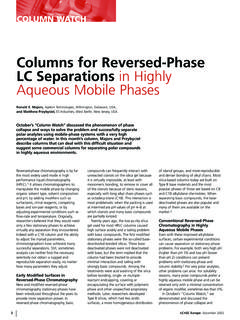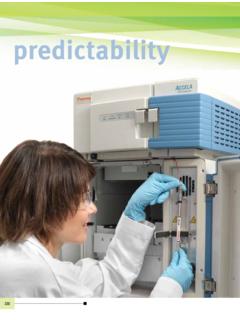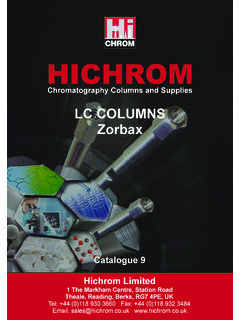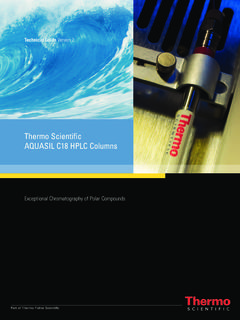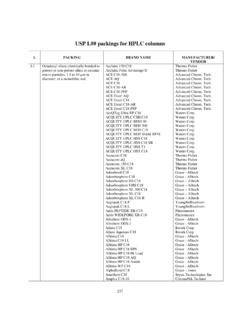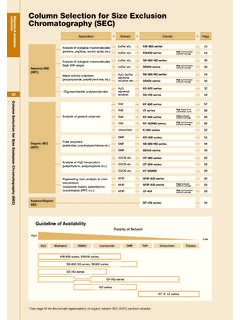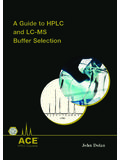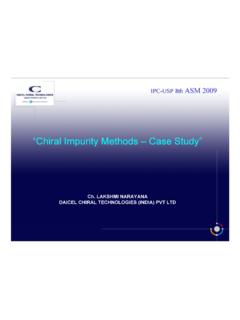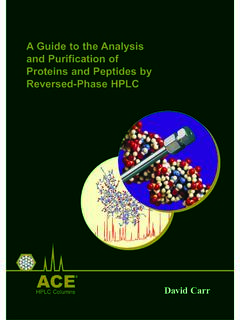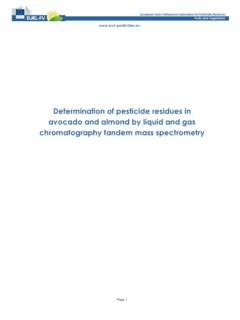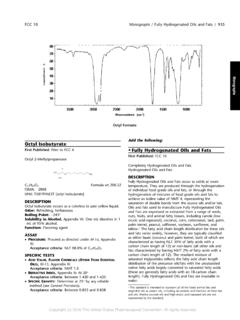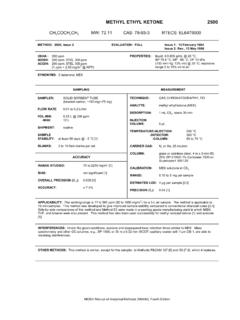Transcription of HPLC Column Classification
1 hplc Column ClassificationBrian Bidlingmeyer,*Agilent;Chung Chow Chan,{Eli Lilly and Company;Patrick Fastino,{FDA;Richard Henry,*ThermoHypersil Keystone;Philip Koerner,*Phenomenex;Anne T. Maule,{3M Pharmaceuticals;Margareth Marques,* Pharmacopeia;Uwe Neue,*Waters;Linda Ng*USP Pharmaceutical Analysis 2 Expert Committee;Horacio Pappa, ;Lane Sander,*NIST;Carmen Santasania,*Supelco;Lloyd Snyder,{LC Resources;Timothy Wozniak,*USPP harmaceutical Analysis 2 Expert CommitteeABSTRACTThisStimuliarticle represents the conclusions and recommendations of the USP Working Group on HPLCC olumns.}}}}
2 The working group included the five largest manufacturers of hplc columns in the United States, along with theNational Institute of Standards and Technology (NIST) and USP. This work attempts to facilitate the selection of hplc columns by the analyst when performing a USP L nomenclature to designate high-performance liquidchromatography ( hplc ) Column type was introduced forthe first time in theFourth SupplementtoUSP XIXin1978. The L1 designation is for columns with octadecilsi-lane as the bonded phase. WhenUSP XXwas publishedin 1980, only seven columns were classified and given abrief description.
3 Since then the list has grown withoutpause to 56 descriptions, some of them very broad or withimprecise wording (1, 2). For years, this classification sys-tem has generated an increasing number of inquiries to USPregarding which Column brand is appropriate for a particularcompendial procedure. Today, Column packings are devel-oped for specific applications, resulting in columns with dis-tinct characteristics even though they belong to the sameoriginal USP classification. For example, more than 220 col-umns currently available in the worldwide market can beclassified as L1, but not all of them have the same applica-tions (3, 4).
4 This situation makes the process of selecting acolumn for a particular application very difficult. The pro-blem is partially controlled by theSystem Suitabilitytest inmost of the USP chromatographic procedures, but in manycases these tests are not conclusive to ensure Column inter-changeability. Evidently the current classification nomen-clature does not provide sufficient information to fill theneeds of modern liquid USP APPROACHIn an attempt to facilitate the selection of possible col-umns by the analyst, the chair of the USP Expert Committee(EC) on Pharmaceutical Analysis 2, Dr.
5 Timothy Wozniak,and the vice-chair of the same EC, Dr. Linda Ng, created agroup to define a proposal about how to subclassify initiallyonly L1 columns , and, perhaps in the future, extend the ap-proach to other USP Column designations. The USP Work-ing Group on hplc columns was created, and itsmembership represented the National Institute of Standardsand Technology (NIST) and the five largest manufacturersof hplc columns in the United States. Dr. Ng chaired the beginning the group considered several existingapproaches. After a series of meetings, they decided touse the NIST Standard Reference Material (SRM) 870 tocarry out the evaluation of C18 columns according to theprocedure described in the certificate of analysis for thisSRM (5, 6).
6 This procedure uses a mixture of five organic compounds(uracil, toluene, ethylbenzene, quinizarin, and amitriptyline)in methanol to characterize Column performance. This testmixture is intended primarilyfor the characterization ofC18 columns used in reversed-phase liquid chromatog-raphy. Selection of the components in SRM 870 was basedon published testing protocols (7, 8) and commercial col-umn literature (9) to provide a broad characterization of col-umn performance in a single, simple the basis of the results obtained and the problemsfaced during the evaluation of the C18 columns using NISTSRM 870, the group identified four parameters to be used inthe characterization of the columns : hydrophobicity (ca-pacity factor of ethylbenzene); chelation (tailing factor ofquinizarin).
7 Activity toward bases (silanol activity, capacityfactor, and tailing factor of amitriptyline); and shape selec-tivity (bonding density). The termshape selectivityis com-monly used to denote a chromatographic quality exhibitedby certain stationary phases for which enhanced separationsof geometric isomers may result based on their molecularstructure rather than other physical or chemical propertiesof the solute (10). Although SRM 870 does not characterizeshape selectivity, the property can be assessed by use ofother chromatographic tests, such as SRM 869a,ColumnSelectivity Test Mixture for Liquid Chromatography,or bymeasuring the bonding density of the stationary phase.
8 *USP Group{PQRI GroupzCorrepondence should be addressed to: Horacio Pappa, 12601 TwinbrookPkwy., Rockville, MD, 20852-1790; e-mail: TO THE REVISION PROCESSP harmacopeial ForumStimuli articles do not necessarily reflect the policiesVol. 31(2) [Mar. Apr. 2005]of the USPC or the USP Council of Experts637#2005 The United States Pharmacopeial Convention, Rights to the Revision ProcessTo compare columns on the same basis, the user shouldevaluate Column performance by separating the mixture iso-cratically using a mobile phase constituted by 80% metha-nol and 20% buffer phosphate at pH certificate of analysis for NIST SRM 870 contains aseries of chromatograms representative of possible types ofretention behavior.}
9 In most instances, peak identificationcan be made on the basis of elution order (uracil, toluene,ethylbenzene) and detector response (quinizarin, amitripty-line). Relative peak areas depend on the detection wave-length. Quinizarin has significant absorbance at 480 nm,and separations of SRM 870 carried out at this wavelengthare selective for this single component. Conversely, quini-zarin exhibits reduced absorbance at 210 nm, permittingmeasurement of amitriptyline in the presence of retention behavior of reversed-phase liquidchromatography (LC) columns often differs in a variety ofways.
10 The components in this test mixture were selected asindicators of several types of chromatographic determination of peak width (efficiency; theoreticalplates), peak asymmetry (AS), absolute retention (k ), andselectivity factor ( , , relative retention,k 1/k 2)forthese components may provide useful measures of component is commonly used as an indicator of thevoid volume (unretained volume) in an LC Column , which isrequired to calculate the retention factor (k ).Toluene/EthylbenzeneThe retention of these compounds can be considered toresult primarily from solvophobic interactions.
